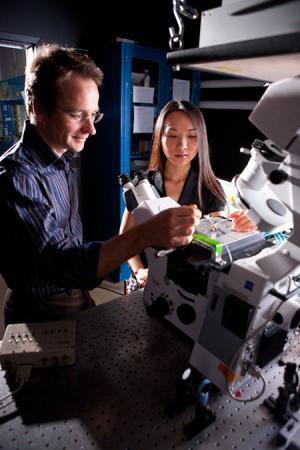ScienceDaily (July 6, 2010) — Clusters of heated, magnetic nanoparticles targeted to cell membranes can remotely control ion channels, neurons and even animal behavior, according to a paper published by University at Buffalo physicists in Nature Nanotechnology.
The research could have broad application, potentially resulting in innovative cancer treatments that remotely manipulate selected proteins or cells in specific tissues, or improved diabetes therapies that remotely stimulate pancreatic cells to release insulin.
The work also could be applied to the development of new therapies for some neurological disorders, which result from insufficient neuro-stimulation.
"By developing a method that allows us to use magnetic fields to stimulate cells both in vitro and in vivo, this research will help us unravel the signaling networks that control animal behavior," says Arnd Pralle, PhD, assistant professor of physics in the UB College of Arts and Sciences and senior/corresponding author on the paper.
The UB researchers demonstrated that their method could open calcium ion channels, activate neurons in cell culture and even manipulate the movements of the tiny nematode, C. elegans.
"We targeted the nanoparticles near what is the 'mouth' of the worms, called the amphid," explains Pralle. "You can see in the video that the worms are crawling around; once we turn on the magnetic field, which heats up the nanoparticles to 34 degrees Celsius, most of the worms reverse course. We could use this method to make them go back and forth. Now we need to find out which other behaviors can be controlled this way." The video is available on YouTube at: http://www.youtube.com/watch?v=u9MqrLcLaCk
The worms reversed course once their temperature reached 34 degrees Celsius, Pralle says, the same threshold that in nature provokes an avoidance response. That's evidence, he says, that the approach could be adapted to whole-animal studies on innovative new pharmaceuticals.
The method the UB team developed involves heating nanoparticles in a cell membrane by exposing them to a radiofrequency magnetic field; the heat then results in stimulating the cell.
"We have developed a tool to heat nanoparticles and then measure their temperature," says Pralle, noting that not much is known about heat conduction in tissue at the nanoscale.
"Our method is important because it allows us to only heat up the cell membrane. We didn't want to kill the cell," he said. "While the membrane outside the cell heats up, there is no temperature change in the cell."
Measuring just six nanometers, the particles can easily diffuse between cells. The magnetic field is comparable to what is employed in magnetic resonance imaging. And the method's ability to activate cells uniformly across a large area indicates that it also will be feasible to use it in in vivo whole body applications, the scientists report.
In the same paper, the UB scientists also report their development of a fluorescent probe to measure that the nanoparticles were heated to 34 degrees Celsius.
"The fluorescence intensity indicates the change in temperature," says Pralle, "it's kind of a nanoscale thermometer and could allow scientists to more easily measure temperature changes at the nanoscale."
Pralle and his co-authors are active in the Molecular Recognition in Biological Systems and Bioinformatics and the Integrated Nanostructure Systems strategic strengths, identified by the UB 2020 strategic planning process.
In addition to Pralle, who has an adjunct position in the Department of Physiology and Biophysics in UB's School of Medicine and Biomedical Sciences, co-authors are Heng Huang and Savas Delikanli, both doctoral students in the UB Department of Physics, Hao Zeng, PhD, associate professor in the physics department, and Denise M. Ferkey, PhD, assistant professor in the UB Department of Biological Sciences.
The research was supported by the National Science Foundation and the UB 2020 Interdisciplinary Research Development Fund.
Story Source:
The above story is reprinted (with editorial adaptations by ScienceDaily staff) from materials provided by University at Buffalo.
Journal Reference:
- Heng Huang, Savas Delikanli, Hao Zeng, Denise M. Ferkey, Arnd Pralle. Remote control of ion channels and neurons through magnetic-field heating of nanoparticles. Nature Nanotechnology, 2010; DOI: 10.1038/nnano.2010.125

